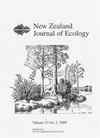北岛kākā (Nestor meridionalis septentrionalis)在Pureora森林公园内的恢复,2000-2020
IF 1.4
3区 环境科学与生态学
Q3 ECOLOGY
引用次数: 0
摘要
为了检验哺乳动物病虫害防治的长期效果,将2008-2020年在普雷奥拉森林公园南怀帕帕生态区内(WEA)的北岛kākā (Nestor meridionalis septentrionalis)密度的年度距离抽样估计值与2000-2007年在同一地点和同一时间(10月)发表的估计值进行了比较。Kākā密度从2000年至2007年的平均0.0.5 (95% CI 0.5 - 0.6)只/公顷增加到2020年的0.2.3 (95% CI 1.9-2.8)只/公顷,增加了约4倍。2000年至2018年的平均增长率为每年6.9%。Kākā恢复可能是多重事件和长期(大约20年),大规模,频繁,有效控制负鼠(Trichosurus vulpecula)和可能的鼬鼠的功能。建议继续进行目前的虫害防治以及kākā和虫害监测。本文章由计算机程序翻译,如有差异,请以英文原文为准。
Recovery of North Island kākā (Nestor meridionalis septentrionalis) within Pureora Forest Park, 2000–2020
: To test the long-term efficacy of mammalian pest control, annual distance sampling estimates of the density of North Island kākā ( Nestor meridionalis septentrionalis ) within the southern Waipapa Ecological Area (WEA), Pureora Forest Park from 2008–2020 are compared to previously published estimates made at the same sites and time of year (October) between 2000–2007. Kākā density increased approximately four-fold from an average of c. 0.5 (95% CI 0.5–0.6) birds ha −1 between 2000 and 2007 to c. 2.3 (95% CI 1.9–2.8) birds ha −1 in 2020. The average of rate of increase between 2000 and 2018 was c. 6.9% per annum. Kākā recovery is likely to be a function of multiple mast events and long-term (> 20 years), large-scale, frequent, effective control of possums ( Trichosurus vulpecula ) and probably mustelids. It is recommended that the current pest control as well as kākā and pest monitoring continue.
求助全文
通过发布文献求助,成功后即可免费获取论文全文。
去求助
来源期刊

New Zealand Journal of Ecology
环境科学-生态学
CiteScore
3.00
自引率
12.50%
发文量
35
审稿时长
>36 weeks
期刊介绍:
The New Zealand Journal of Ecology is a biannual peer-reviewed journal publishing ecological research relevant to New Zealand/Aotearoa and the South Pacific. It has been published since 1952 (as a 1952 issue of New Zealand Science Review and as the Proceedings of the New Zealand Ecological Society until 1977). The Journal is published by the New Zealand Ecological Society (Inc.), and is covered by Current Contents/Agriculture, Biology and Environmental Science, GEOBASE, and Geo Abstracts.
 求助内容:
求助内容: 应助结果提醒方式:
应助结果提醒方式:


